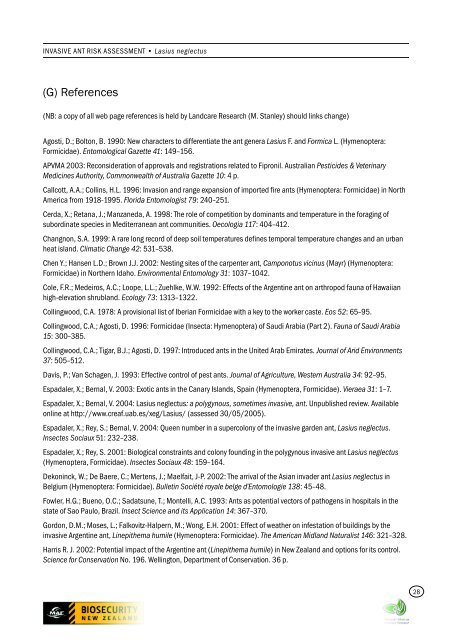Lasius neglectus (A) PEST INFORMATION - Biosecurity New Zealand
Lasius neglectus (A) PEST INFORMATION - Biosecurity New Zealand
Lasius neglectus (A) PEST INFORMATION - Biosecurity New Zealand
You also want an ePaper? Increase the reach of your titles
YUMPU automatically turns print PDFs into web optimized ePapers that Google loves.
INVASIVE ANT RISK ASSESSMENT • <strong>Lasius</strong> <strong>neglectus</strong><br />
(G) References<br />
(NB: a copy of all web page references is held by Landcare Research (M. Stanley) should links change)<br />
Agosti, D.; Bolton, B. 1990: <strong>New</strong> characters to differentiate the ant genera <strong>Lasius</strong> F. and Formica L. (Hymenoptera:<br />
Formicidae). Entomological Gazette 41: 149–156.<br />
APVMA 2003: Reconsideration of approvals and registrations related to Fipronil. Australian Pesticides & Veterinary<br />
Medicines Authority, Commonwealth of Australia Gazette 10: 4 p.<br />
Callcott, A.A.; Collins, H.L. 1996: Invasion and range expansion of imported fire ants (Hymenoptera: Formicidae) in North<br />
America from 1918-1995. Florida Entomologist 79: 240–251.<br />
Cerda, X.; Retana, J.; Manzaneda, A. 1998: The role of competition by dominants and temperature in the foraging of<br />
subordinate species in Mediterranean ant communities. Oecologia 117: 404–412.<br />
Changnon, S.A. 1999: A rare long record of deep soil temperatures defines temporal temperature changes and an urban<br />
heat island. Climatic Change 42: 531–538.<br />
Chen Y.; Hansen L.D.; Brown J.J. 2002: Nesting sites of the carpenter ant, Camponotus vicinus (Mayr) (Hymenoptera:<br />
Formicidae) in Northern Idaho. Environmental Entomology 31: 1037–1042.<br />
Cole, F.R.; Medeiros, A.C.; Loope, L.L.; Zuehlke, W.W. 1992: Effects of the Argentine ant on arthropod fauna of Hawaiian<br />
high-elevation shrubland. Ecology 73: 1313–1322.<br />
Collingwood, C.A. 1978: A provisional list of Iberian Formicidae with a key to the worker caste. Eos 52: 65–95.<br />
Collingwood, C.A.; Agosti, D. 1996: Formicidae (Insecta: Hymenoptera) of Saudi Arabia (Part 2). Fauna of Saudi Arabia<br />
15: 300–385.<br />
Collingwood, C.A.; Tigar, B.J.; Agosti, D. 1997: Introduced ants in the United Arab Emirates. Journal of Arid Environments<br />
37: 505–512.<br />
Davis, P.; Van Schagen, J. 1993: Effective control of pest ants. Journal of Agriculture, Western Australia 34: 92–95.<br />
Espadaler, X.; Bernal, V. 2003: Exotic ants in the Canary Islands, Spain (Hymenoptera, Formicidae). Vieraea 31: 1–7.<br />
Espadaler, X.; Bernal, V. 2004: <strong>Lasius</strong> <strong>neglectus</strong>: a polygynous, sometimes invasive, ant. Unpublished review. Available<br />
online at http://www.creaf.uab.es/xeg/<strong>Lasius</strong>/ (assessed 30/05/2005).<br />
Espadaler, X.; Rey, S.; Bernal, V. 2004: Queen number in a supercolony of the invasive garden ant, <strong>Lasius</strong> <strong>neglectus</strong>.<br />
Insectes Sociaux 51: 232–238.<br />
Espadaler, X.; Rey, S. 2001: Biological constraints and colony founding in the polygynous invasive ant <strong>Lasius</strong> <strong>neglectus</strong><br />
(Hymenoptera, Formicidae). Insectes Sociaux 48: 159–164.<br />
Dekoninck, W.; De Baere, C.; Mertens, J.; Maelfait, J-P. 2002: The arrival of the Asian invader ant <strong>Lasius</strong> <strong>neglectus</strong> in<br />
Belgium (Hymenoptera: Formicidae). Bulletin Société royale belge d’Entomologie 138: 45–48.<br />
Fowler, H.G.; Bueno, O.C.; Sadatsune, T.; Montelli, A.C. 1993: Ants as potential vectors of pathogens in hospitals in the<br />
state of Sao Paulo, Brazil. Insect Science and its Application 14: 367–370.<br />
Gordon, D.M.; Moses, L.; Falkovitz-Halpern, M.; Wong, E.H. 2001: Effect of weather on infestation of buildings by the<br />
invasive Argentine ant, Linepithema humile (Hymenoptera: Formicidae). The American Midland Naturalist 146: 321–328.<br />
Harris R. J. 2002: Potential impact of the Argentine ant (Linepithema humile) in <strong>New</strong> <strong>Zealand</strong> and options for its control.<br />
Science for Conservation No. 196. Wellington, Department of Conservation. 36 p.<br />
28
















